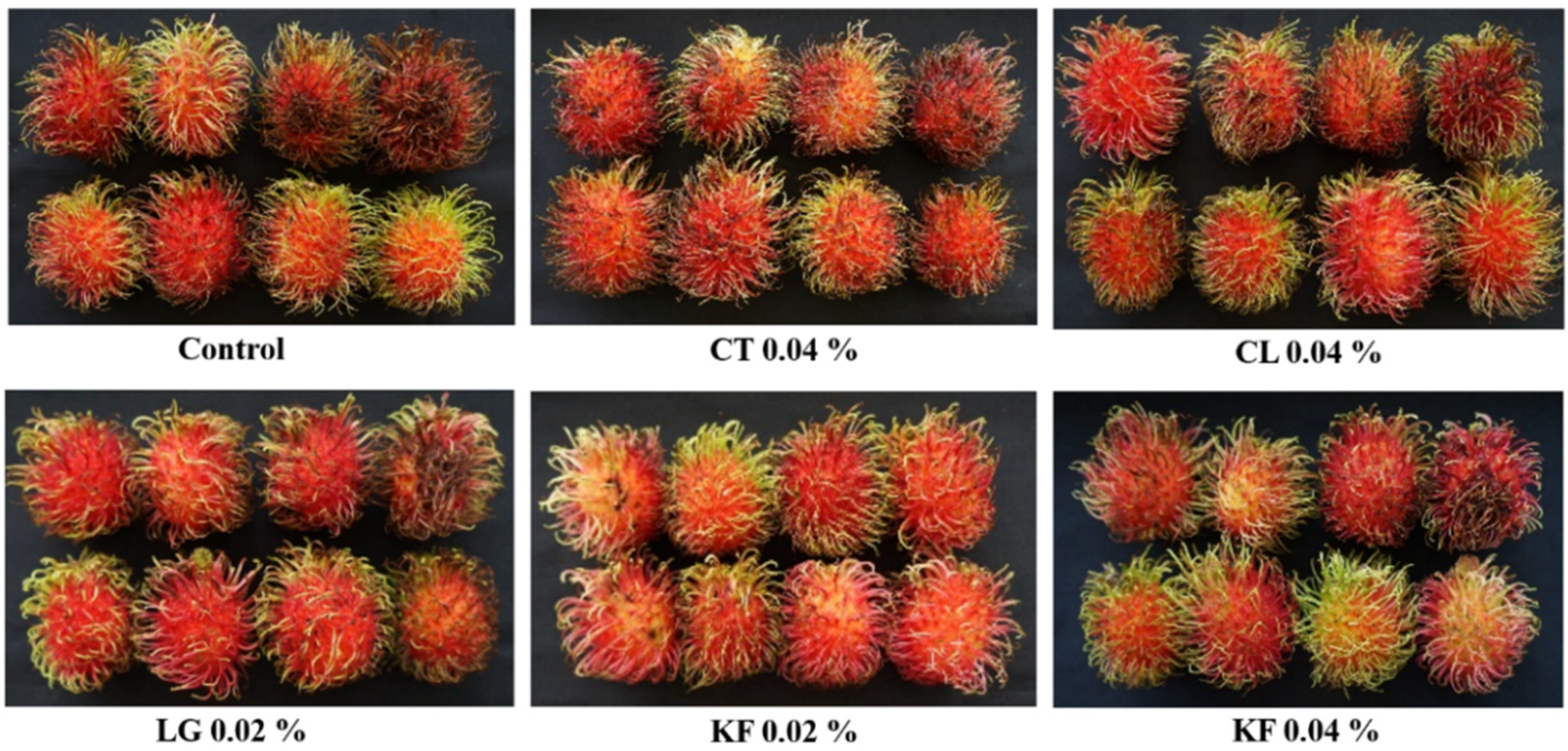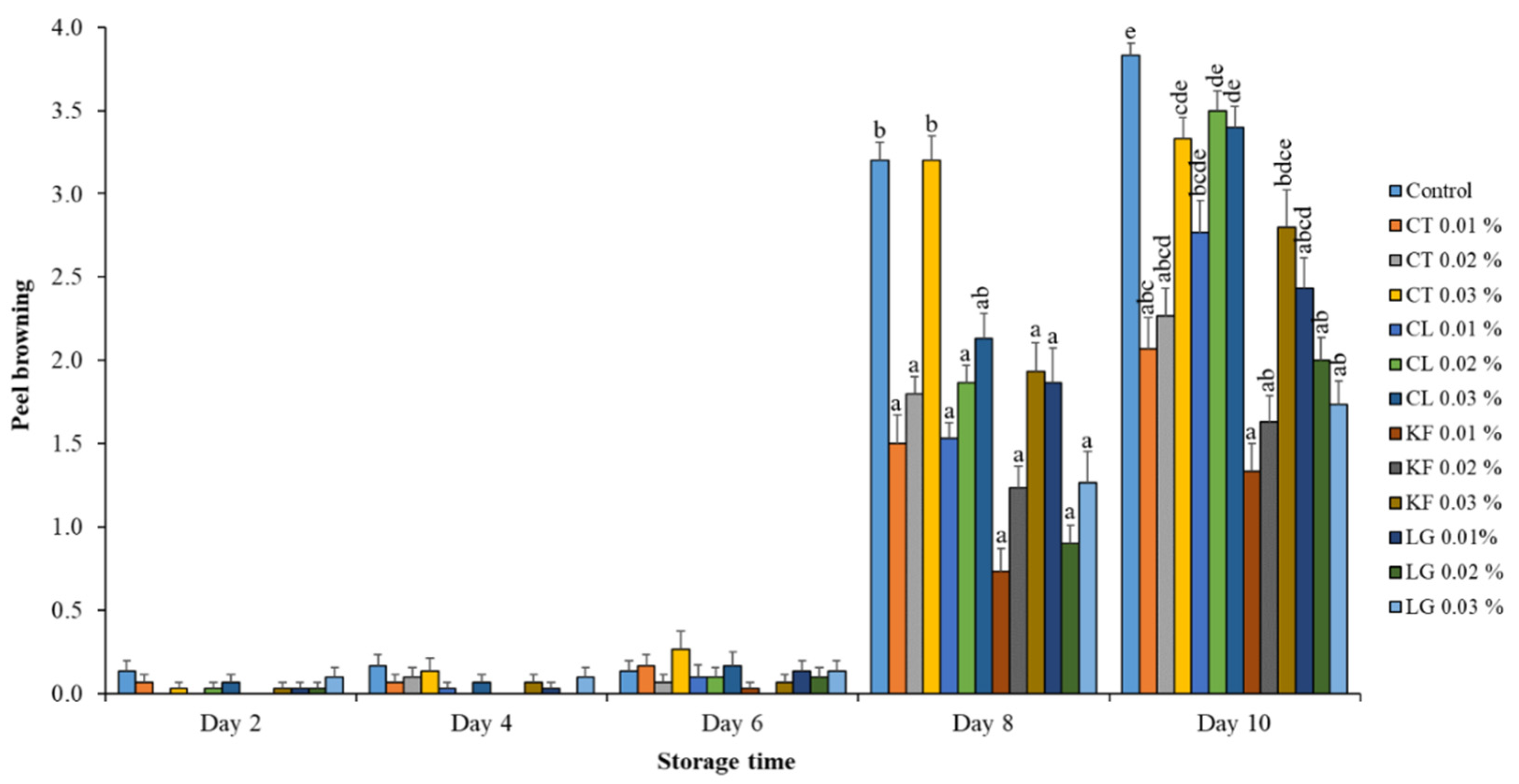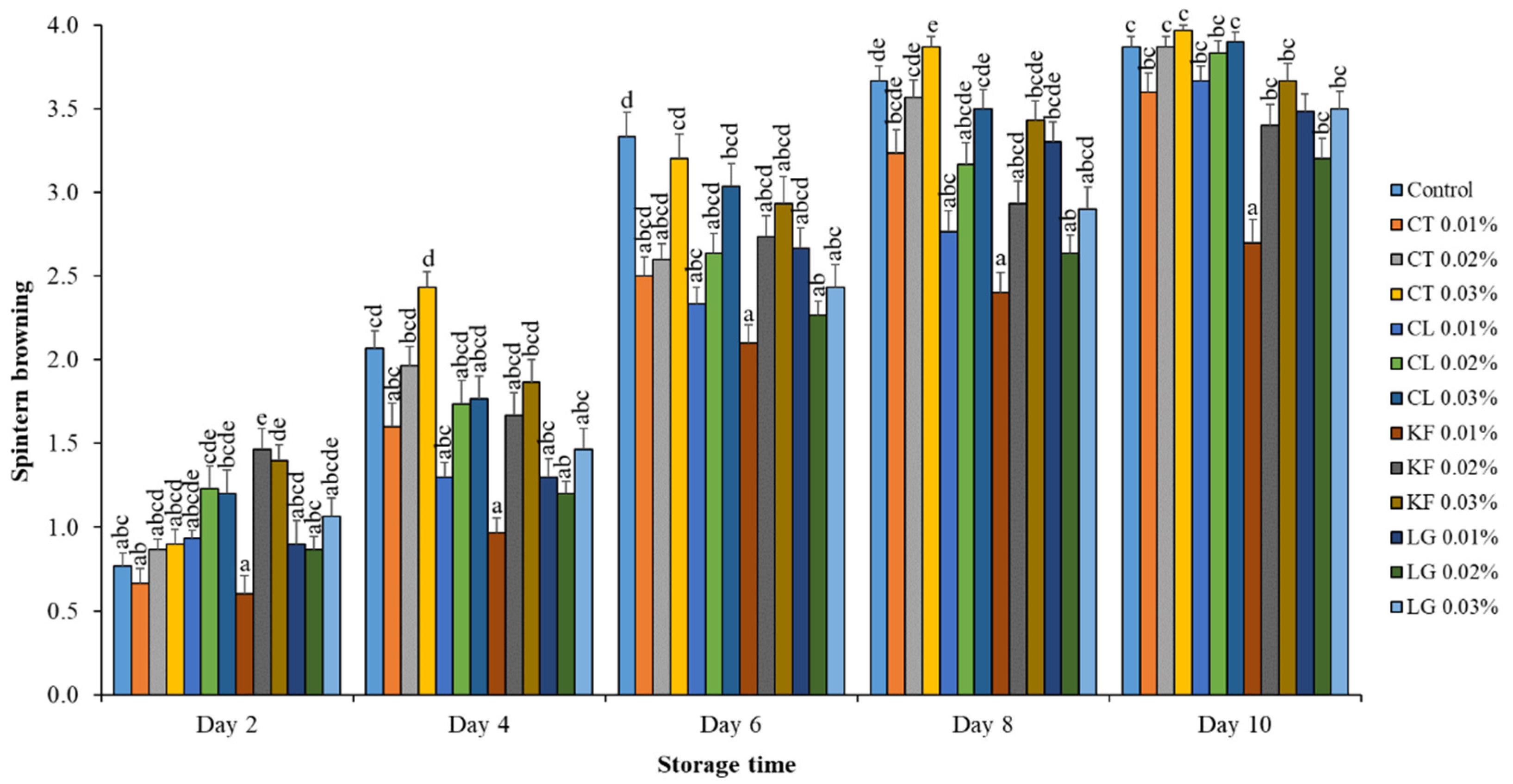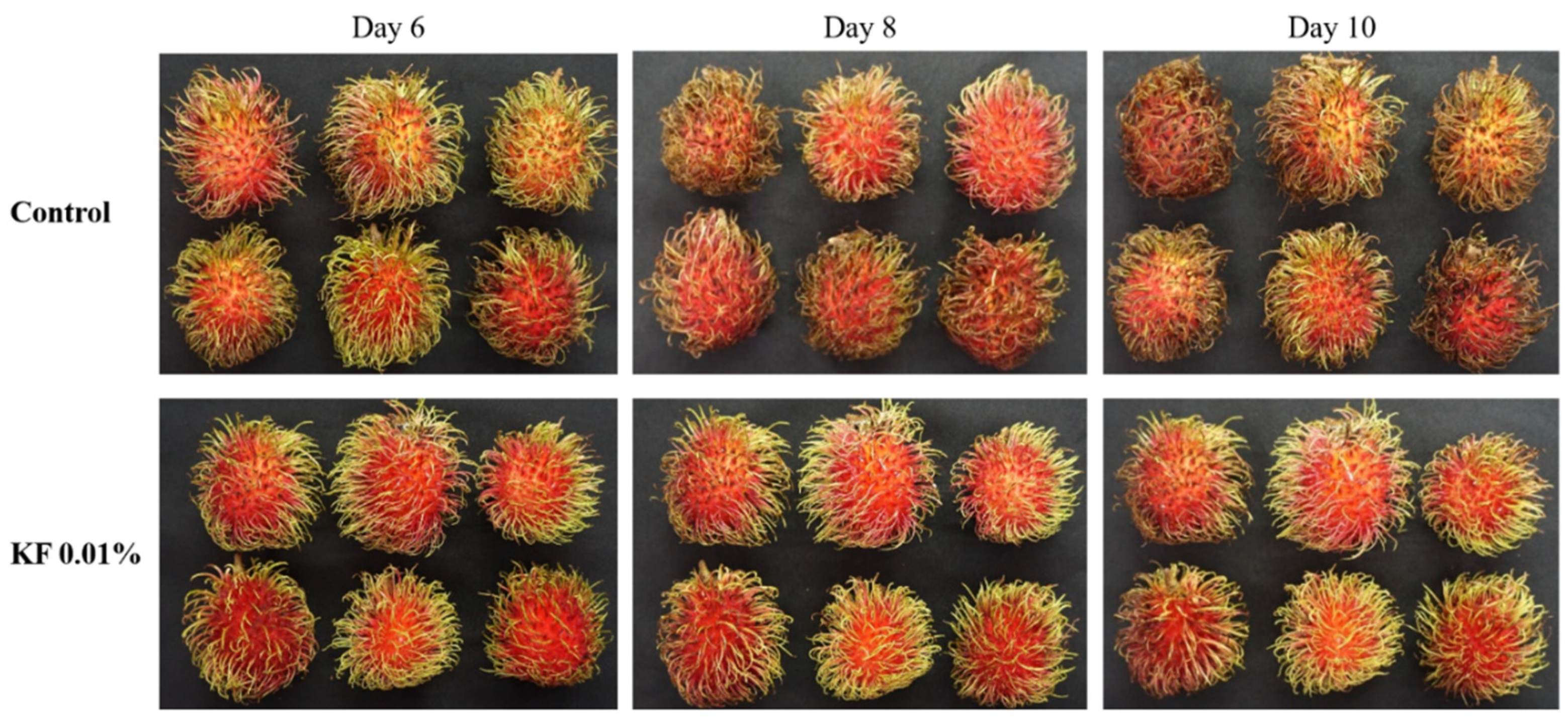Application of Essential Oils for Maintaining Postharvest Quality of ‘Rongrien’ Rambutan Fruit
Abstract
1. Introduction
2. Materials and Methods
2.1. Plant Material
2.2. Essential Oil Coating Treatment
2.3. Fruit Quality Assessment
2.3.1. Weight Loss
2.3.2. Evaluation of Pericarp Browning
2.4. Data Analysis
3. Results
3.1. Effects of Citronella Oil (CT) Coating
3.2. Effect of Clove Oil (CL) Coating
3.3. Effect of Kaffir Lime Oil (KF) Coating
3.4. Effect of Lemongrass Oil (LG) Coating
3.5. Comparison of Selected Essential Oil Treatments
4. Discussion
5. Conclusions
Author Contributions
Funding
Data Availability Statement
Acknowledgments
Conflicts of Interest
References
- Yingsanga, P.; Srilaong, V.; McGlasson, W.B.; Kabanoff, E.; Kanlayanarat, S.; Noichinda, S. Morphological differences associated with water loss in Rambutan fruit cv. Rongrien and See-chompoo. Acta Hortic. 2006, 712, 453–459. [Google Scholar] [CrossRef]
- Yingsanga, P.; Srilaong, V.; Kanlayanarat, S.; Noichinda, S.; McGlasson, W.B. Relationship between browning and related enzymes (PAL, PPO and POD) in rambutan fruit (Nephelium lappaceum Linn.) cvs. Rongrien and See-Chompoo. Postharvest Biol. Technol. 2008, 50, 164–168. [Google Scholar] [CrossRef]
- Julianti, E.; Ridwansyah; Yusraini, E.; Suhaidi, I. Effect of Modified Atmosphere Packaging on Postharvest Quality of Rambutan cv. Binjai. J. Food Sci. Eng. 2012, 2, 111–117. [Google Scholar] [CrossRef]
- Jitareerat, P.; Sripong, K.; Puangnim, S.; Aiamla-or, S.; Limmatvapirat, S.; Uthairatanakij, A. Effects of shellac and modified coconut oil on the quality of gamma irradiated rambutan fruit. Acta Hortic. 2018, 1210, 139–144. [Google Scholar] [CrossRef]
- Bakkali, F.; Averbeck, S.; Averbeck, D.; Idaomar, I. Biological effects of essential oils-a review. Food Chem. Toxicol. 2008, 46, 446–475. [Google Scholar] [CrossRef] [PubMed]
- Sanchez-Gonzalez, L.; Vargas, M.; Gonzalez-Martinez, C.; Chiralt, A.; Chafer, M. Use of Essential Oils in Bioactive Edible Coatings. Food Eng. Rev. 2011, 3, 1–16. [Google Scholar] [CrossRef]
- Schaneberg, B.T.; Khan, I.A. Comparison of extraction methods for marker compounds in the essential oil of lemon grass by GC. J. Agric. Food Chem. 2002, 50, 1345–1349. [Google Scholar] [CrossRef]
- Desai, M.A.; Parikh, J. Extraction of essential oil from leaves of lemongrass using microwave radiation: Optimization, comparative, kinetic, and biological studies. ACS Sustain. Chem. Eng. 2015, 3, 421–431. [Google Scholar] [CrossRef]
- Juven, B.J.; Kanner, J.; Schved, F.; Weisslowicz, H. Factors that interact with the antibacterial action of thyme and its active constituents. J. Appl. Bacteriol. 1994, 76, 626–631. [Google Scholar] [CrossRef]
- Tzortzakis, N.G. Maintaining postharvest quality of fresh produce with volatile compounds. Innov. Food Sci. Emerg. Technol. 2007, 8, 111–116. [Google Scholar] [CrossRef]
- Raybaudi-Massilia, R.M.; Mosqueda-Melgar, J.; Martin-Belloso, O. Edible alginate-based coating as carrier of antimicrobials to improve shelf-life and safety of fresh-cut melon. Int. J. Food Microbiol. 2008, 121, 313–327. [Google Scholar] [CrossRef] [PubMed]
- Juliano, C.; Demurtas, C.; Piu, L. In vitro study on the anticandidal activity of Melaleuca alternifolia (tea tree) essential oil combined with chitosan. Flavour Fragr. J. 2008, 23, 227–231. [Google Scholar] [CrossRef]
- Sivakumar, D.; Wijeratnama, R.S.W.; Wijesunderab, R.L.C.; Abeyesekere, M. Control of postharvest diseases of rambutan using cinnamaldehyde. Crop Prot. 2002, 21, 847–852. [Google Scholar] [CrossRef]
- Phuoc, M.N. Incorporation of turmeric oil into chitosan edible coating in preservation of rambutan fruit, Nephelium lappaceum. J. Entomol. Res. 2020, 44, 179–182. [Google Scholar] [CrossRef]
- Ali, A.; Noh, N.M.; Mustafa, M.A. Antimicrobial activity of chitosan enriched with lemongrass oil against anthracnose of bell pepper. Food Packag. Shelf Life 2015, 3, 56–61. [Google Scholar] [CrossRef]
- Bosquez-Molina, E.; Ronquillo-de Jesús, E.; Bautista-Banos, S.; Verde-Calvo, J.R.; Morales-Lopez, J. Inhibitory effect of essential oils against Colletotrichum gloeosporioides and Rhizopus stolonifer in stored papaya fruit and their possible application in coatings. Postharvest Biol. Technol. 2010, 57, 132–137. [Google Scholar] [CrossRef]
- Bill, M.; Sivakumar, D.; Korsten, L.; Thompson, A.K. The efficacy of combined application of edible coatings and thyme oil in inducing resistance components in avocado (Persea americana Mill.) against anthracnose during post-harvest storage. Crop Prot. 2014, 64, 159–167. [Google Scholar] [CrossRef]
- Combrinck, S.; Regnier, T.; Kamatou, G.P.P. In vitro activity of eighteen essential oils and some major components against common postharvest fungal pathogens of fruit. Ind. Crop. Prod. 2011, 33, 344–349. [Google Scholar] [CrossRef]
- Serrano, M.; Valverde, J.M.; Guillen, F.; Castillo, S.; Martinez-Romero, D.; Valero, D. Use of Aloe vera gel coating preserves the functional properties of table grapes. J. Agric. Food Chem. 2006, 54, 3882–3886. [Google Scholar] [CrossRef]
- Majewska, E.; Kozowska, M.; Gruczyska-Skowska, E.; Kowalska, D.; Tarnowska, K. Lemongrass (Cymbopogon citratus) Essential Oil: Extraction, Composition, Bioactivity and Uses for Food Preservation-a Review. Pol. J. Food Nutr. Sci. 2019, 69, 327–341. [Google Scholar] [CrossRef]
- Hong, K.; Xie, J.; Zhang, L.; Sun, D.; Gong, D. Effects of chitosan coating on posharvest life and qualitly of guava (Psidium guajava L.) fruit during cold storage. Sci. Hortic. 2012, 144, 172–178. [Google Scholar] [CrossRef]
- Srilaong, V.; Kanlayanarat, S.; Tatsumi, Y. Changes in commercial quality of ‘Rong-Rien’ rambutan in modified atmosphere packaging. Food Sci. Technol. Res. 2002, 8, 337–341. [Google Scholar] [CrossRef][Green Version]
- Jia, B.; Xu, L.; Guan, W.; Lin, Q.; Brennan, C.; Yan, R.; Zhao, H. Effect of citronella essential oil fumigation on sprout suppression and quality of potato tubers during storage. Food Chem. 2019, 284, 254–258. [Google Scholar] [CrossRef]
- Hasheminejad, N.; Khodaiyan, F. The effect of clove essential oil loaded chitosan nanoparticles on the shelf life and quality of pomegranate arils. Food Chem. 2020, 309, 1–10. [Google Scholar] [CrossRef]
- Kim, I.H.; Oh, Y.A.; Lee, H.; Song, K.B.; Min, S.C. Grape berry coatings of lemongrass oil-incorporating nanoemulsion. LWT-Food Sci. Technol. 2014, 58, 1–10. [Google Scholar] [CrossRef]
- Azarakhsh, N.; Osman, A.; Ghazali, H.M.; Tan, C.P.; Adzahan, N.M. Lemongrass essential oil incorporated into alginate-based edible coating for shelf-life extension and quality retention of fresh-cut pineapple. Postharvest Biol. Technol. 2014, 88, 1–7. [Google Scholar] [CrossRef]
- Rojas-Graü, M.A.; Raybaudi-Massilia, R.M.; Soliva-Fortuny, R.C.; Avena-Bustillos, R.J.; McHugh, T.H.; Martín-Belloso, O. Apple puree-alginate edible coating as carrier of antimicrobial agents to prolong shelf-life of fresh-cut apples. Postharvest Biol. Technol. 2007, 45, 254–264. [Google Scholar] [CrossRef]





| Parameters | Treatment | Storage Time | |||
|---|---|---|---|---|---|
| Day 3 | Day 6 | Day 9 | Day 12 | ||
| Weight loss | Control | 1.3 ± 0.1 a | 2.6 ± 0.2 a | 4.4 ± 0.7 a | 5.9 ± 0.6 a |
| (%) | CT 0.04% | 1.8 ± 0.5 a | 2.4 ± 0.2 a | 4.1 ± 0.4 a | 5.3 ± 0.1 a |
| CT 0.08% | 2.0 ± 0.4 a | 3.8 ± 0.6 b | N/A | N/A | |
| CT 0.16% | 1.7 ± 0.2 a | 3.1 ± 0.4 ab | N/A | N/A | |
| Peel browning | Control | 0.0 ± 0.0 a | 0.1 ± 0.0 a | 0.7 ± 0.1 a | 1.0 ± 0.0 a |
| (score 0–4) | CT 0.04% | 1.0 ± 0.0 b | 1.3 ± 0.1 b | 1.7 ± 0.1 b | 1.3 ± 0.1 b |
| CT 0.08% | 1.5 ± 0.1 c | 2.3 ± 0.1 c | N/A | N/A | |
| CT 0.16% | 2.8 ± 0.1 d | 2.9 ± 0.1 d | N/A | N/A | |
| Spintern browning | Control | 0.0 ± 0.0 a | 0.5 ± 0.1 a | 1.3 ± 0.1 a | 2.3 ± 0.2 a |
| (score 0–4) | CT 0.04% | 0.1 ± 0.0 a | 1.7 ± 0.1 b | 2.3 ± 0.1 b | 2.7 ± 0.1 b |
| CT 0.08% | 1.1 ± 0.2 b | 3.1 ± 0.1 c | N/A | N/A | |
| CT 0.16% | 2.3 ± 0.1 c | 3.8 ± 0.1 d | N/A | N/A | |
| Parameters | Treatment | Storage Time | |||
|---|---|---|---|---|---|
| Day 3 | Day 6 | Day 9 | Day 12 | ||
| Weight loss | Control | 1.3 ± 0.1 a | 2.6 ± 0.2 a | 4.4 ± 0.7 a | 5.9 ± 0.6 a |
| (%) | CL 0.04% | 1.7 ± 0.1 a | 3.1 ± 0.5 a | 4.6 ± 0.5 a | 6.4 ± 0.4 a |
| CL 0.08% | 2.0 ± 0.4 a | 3.0 ± 0.3 a | 4.3 ± 0.3 a | 6.0 ± 0.5 a | |
| CL 0.16% | 1.4 ± 0.0 a | 2.7 ± 0.1 a | 4.7 ± 0.2 a | 7.8 ± 0.9 a | |
| Peel browning | Control | 0.0 ± 0.0 a | 0.1 ± 0.0 a | 0.7 ± 0.1 a | 1.0 ± 0.0 a |
| (score 0–4) | CL 0.04% | 0.0 ± 0.0 a | 0.3 ± 0.1 a | 1.3 ± 0.1 b | 1.1 ± 0.0 a |
| CL 0.08% | 0.2 ± 0.1 b | 0.8 ± 0.1 b | 1.5 ± 0.1 b | 1.4 ± 0.1 b | |
| CL 0.16% | 0.4 ± 0.1 c | 1.4 ± 0.1 c | 2.0 ± 0.1 c | 1.6 ± 0.1 b | |
| Spintern browning | Control | 0.0 ± 0.0 a | 0.5 ± 0.1 a | 1.3 ± 0.1 a | 2.3 ± 0.2 a |
| (score 0–4) | CL 0.04% | 0.0 ± 0.0 a | 0.7 ± 0.1 a | 1.6 ± 0.1 b | 2.1 ± 0.1 a |
| CL 0.08% | 0.0 ± 0.0 a | 1.1 ± 0.1 b | 2.0 ± 0.1 c | 2.7 ± 0.1 b | |
| CL 0.16% | 0.1 ± 0.0 a | 1.8 ± 0.1 c | 2.8 ± 0.1 d | 2.9 ± 0.1 b | |
| Parameters | Treatment | Storage Time | ||
|---|---|---|---|---|
| Day 6 | Day 9 | Day 12 | ||
| Weight loss | Control | 4.1 ± 0.6 a | 5.8 ± 0.6 a | 7.3 ± 0.6 a |
| (%) | KF 0.02% | 3.3 ± 0.5 a | 5.1 ± 0.6 a | 7.0 ± 0.8 a |
| KF 0.04% | 3.6 ± 0.3 a | 5.6 ± 0.4 a | 7.5 ± 0.4 a | |
| KF 0.08% | 4.1 ± 0.5 a | 5.7 ± 0.6 a | 7.1 ± 0.6 a | |
| Peel browning | Control | 0.1 ± 0.0 a | 1.0 ± 0.1 c | 0.8 ± 0.1 a |
| (score 0–4) | KF 0.02% | 0.2 ± 0.1 ab | 0.1 ± 0.1 a | 0.5 ± 0.1 a |
| KF 0.04% | 0.4 ± 0.1 b | 0.3 ± 0.1 ab | 1.1 ± 0.1 b | |
| KF 0.08% | 0.4 ± 0.1 b | 0.6 ± 0.1 b | 1.1 ± 0.1 b | |
| Spintern browning | Control | 0.3 ± 0.1 a | 1.5 ± 0.2 b | 2.6 ± 0.1 ab |
| (score 0–4) | KF 0.02% | 0.1 ± 0.1 a | 1.0 ± 0.1 a | 2.2 ± 0.1 a |
| KF 0.04% | 0.6 ± 0.1 b | 1.3 ± 0.1 ab | 2.3 ± 0.2 ab | |
| KF 0.08% | 0.6 ± 0.1 b | 1.2 ± 0.1 ab | 2.7 ± 0.1 b | |
| Parameters | Treatment | Storage Time | ||
|---|---|---|---|---|
| Day 6 | Day 9 | Day 12 | ||
| Weight loss | Control | 4.1 ± 0.6 a | 5.8 ± 0.6 a | 7.3 ± 0.6 a |
| (%) | LG 0.02% | 3.6 ± 0.2 a | 5.4 ± 0.2 a | 6.5 ± 0.0 a |
| LG 0.04% | N/A | N/A | N/A | |
| LG 0.08% | N/A | N/A | N/A | |
| Peel browning | Control | 0.1 ± 0.0 a | 1.0 ± 0.1 a | 0.8 ± 0.1 a |
| (score 0–4) | LG 0.02% | 1.1 ± 0.1 b | 1.3 ± 0.1 b | 1.3 ± 0.1 b |
| LG 0.04% | N/A | N/A | N/A | |
| LG 0.08% | N/A | N/A | N/A | |
| Spintern browning | Control | 0.3 ± 0.1 a | 1.5 ± 0.2 a | 2.6 ± 0.1 a |
| (score 0–4) | LG 0.02% | 1.0 ± 0.1 b | 2.5 ± 0.1 b | 2.7 ± 0.2 a |
| LG 0.04% | N/A | N/A | N/A | |
| LG 0.08% | N/A | N/A | N/A | |
Publisher’s Note: MDPI stays neutral with regard to jurisdictional claims in published maps and institutional affiliations. |
© 2021 by the authors. Licensee MDPI, Basel, Switzerland. This article is an open access article distributed under the terms and conditions of the Creative Commons Attribution (CC BY) license (https://creativecommons.org/licenses/by/4.0/).
Share and Cite
Ummarat, N.; Seraypheap, K. Application of Essential Oils for Maintaining Postharvest Quality of ‘Rongrien’ Rambutan Fruit. Agriculture 2021, 11, 1204. https://doi.org/10.3390/agriculture11121204
Ummarat N, Seraypheap K. Application of Essential Oils for Maintaining Postharvest Quality of ‘Rongrien’ Rambutan Fruit. Agriculture. 2021; 11(12):1204. https://doi.org/10.3390/agriculture11121204
Chicago/Turabian StyleUmmarat, Nittaya, and Kanogwan Seraypheap. 2021. "Application of Essential Oils for Maintaining Postharvest Quality of ‘Rongrien’ Rambutan Fruit" Agriculture 11, no. 12: 1204. https://doi.org/10.3390/agriculture11121204
APA StyleUmmarat, N., & Seraypheap, K. (2021). Application of Essential Oils for Maintaining Postharvest Quality of ‘Rongrien’ Rambutan Fruit. Agriculture, 11(12), 1204. https://doi.org/10.3390/agriculture11121204






